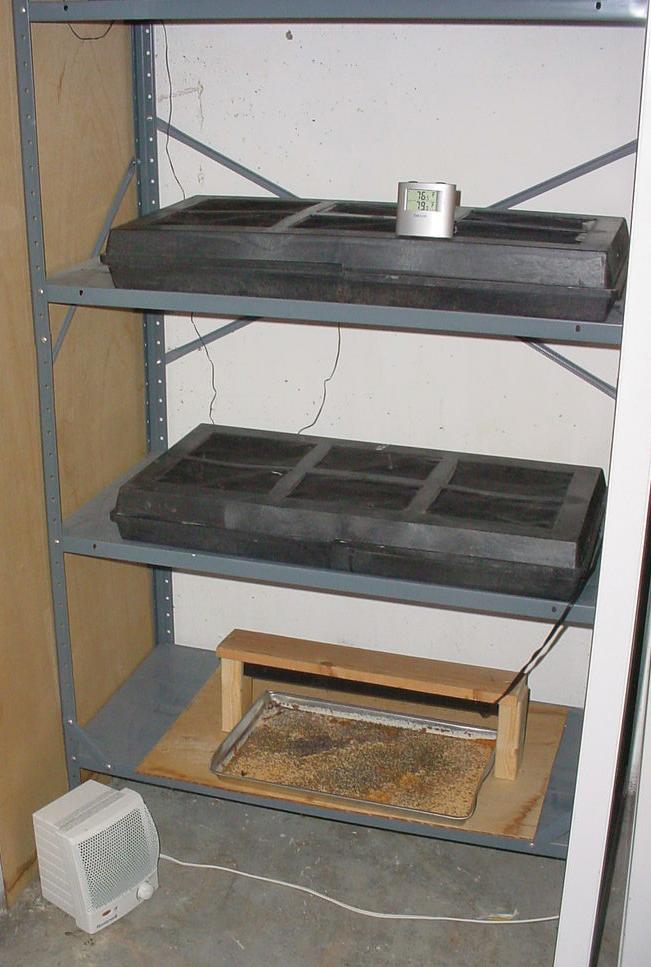
Filled nest blocks can be stored in field shelters or in an unheated building. Bees allowed to overwinter this way under ambient temperatures will typically begin emerging from the nests in early to mid-June and have an extended emergence period that lasts weeks or even months. If the nest blocks are left in field shelters, the shelters must be secured against woodpeckers and rodents with hardware cloth or something similar. Cold weather does not normally injure bees in most parts of the US, and bees can withstand temperatures as low as 15°F (-9.4°C) for short periods of time with little mortality. Exposure to extended periods of freezing temperatures should be avoided. Conversely, warm winter temperatures should also be avoided as some nest-destroying insect pests and parasites may be active at temperatures above 40°F (4.4°C). Filled nest blocks can also be refrigerated; however, few producers have the facilities to store many large nest blocks under climate controlled conditions. During development, either at ambient temperatures or in the incubator, some larvae may spin their cocoons facing the wrong direction. When these bees emerge they then attempt to exit the nest in the wrong direction (toward the back of the nest), possibly killing themselves and other bees in their path. Therefore, if bees are left in nest blocks, the nest blocks should be stored with the tunnel entrances facing up. Bees stored in this way use gravity to determine which way to spin their cocoon, and ultimately exit the nest properly.
More commonly, bees are removed from the nest blocks and stored as loose cells under refrigerated conditions. Feed sacks, buckets, and 50-gallon drums with holes for air circulation are all commonly used to store loose cells. Plastic bags or other airtight containers should be avoided because mold buildup can be lethal to larvae. Cells should also be thoroughly dried before being refrigerated.
Large producers often have walk-in coolers or refrigerated semi trailers that double as incubation rooms. In some areas, seed companies and warehouses also provide cold storage for a fee. Storage temperatures between 35° and 40°F (1.7° and 4.4°C) at 50 percent relative humidity are ideal for both loose cells and filled nest blocks Ordinary home air conditioners are not suitable for maintaining these temperatures—professional refrigeration systems are required. Bees may remain dormant at temperatures up to around 60°F (15.6°C); however, mortality may rise as bees metabolize stored energy reserves at these higher temperatures. Similarly, bees stored at warmer temperatures take significantly longer to emerge. A storage period of 150 to 210 days at 35°F (1.7°C) is probably close to ideal. Dormant bees cannot be stored for more than one season.
The advantages of cold storage and incubation are that pest activity can be arrested, storage space is reduced, and nest blocks can be cleaned and disinfected while the bees are dormant. By combining controlled refrigeration and incubation, bee emergence can be timed to match the onset of peak bloom periods.
Incubation rooms should be well insulated and have sufficient air circulation to prevent hot or cold spots. Rooms should have adequate shelving to hold trays containing loose cells or filled nest blocks. Dark rooms are also preferable as they increase the effectiveness of light traps for parasites, and reduce stress on the bees.
Thermostatically controlled electric space heaters (Figure 7.20) and properly vented fuel-burning heaters can be used.
Whatever type of heat source is used, fans should also be used to achieve a consistent temperature throughout the room. Elaborate rooms used for both cold storage and incubation will include separate heating and cooling thermostats and programmable Sensaphone-type room alarms to monitor temperature and humidity inside the incubator. These room alarms normally have an automatic telephone dialer that will contact you if temperature or humidity levels rise or fall outside of established parameters.
Bees should be placed in sterilized wood, plastic, or Styrofoam incubation trays with tight-fitting screened tops if they are being incubated as loose cells. Since bees give off heat during the development process, incubation trays should not be filled to a depth greater than one inch to prevent cells in the middle of the tray from overheating. A space should be maintained between stacked trays to allow for air circulation.
Incubation should occur at 85°F (29.4°C). Temperatures higher than 90°F (32.2°C) can be lethal to developing bees. Relative humidity lower than 70 percent can result in developmental deformities. A normal household humidifier can be used inside the incubator. Light traps to control parasites will also add to the overall humidity.
Under the controlled conditions recommended here, the first male bees will emerge around 18 days into the incubation, with the first female bees emerging around two days later. If release conditions are unfavorable (cool, wet weather, pesticide spraying, or delayed bloom), bee emergence can be delayed up to one week by reducing the temperature to 65°F (18.3°C) on the 14th day of incubation (see sidebar).
Upon emergence bees should be fed twice daily inside the incubation trays until release with a honey-water solution (1:1 ratio) sprayed onto paper towels and laid across the screened tops of the trays. Since bees extend their tongues through the screen to feed, you should not rub your hands or the paper towels across the screen since this can injure the bees. By the 22nd day, the trays should be taken to the field for release.
Some large producers use a different incubation method called a “bleed-off system.” In these systems bees are incubated in open trays in completely dark rooms. As the bees emerge, they are attracted to a single black light placed in a room either adjacent to, or more commonly below, the incubation room. Funnel-shaped chutes guide the bees into storage containers filled with packing excelsior (to prevent the bees from smothering each other) located inside a room which is chilled to 50°F (10°C). The bees remain immobile at these temperatures and can be held for several days. They are then periodically collected and released in the field.
